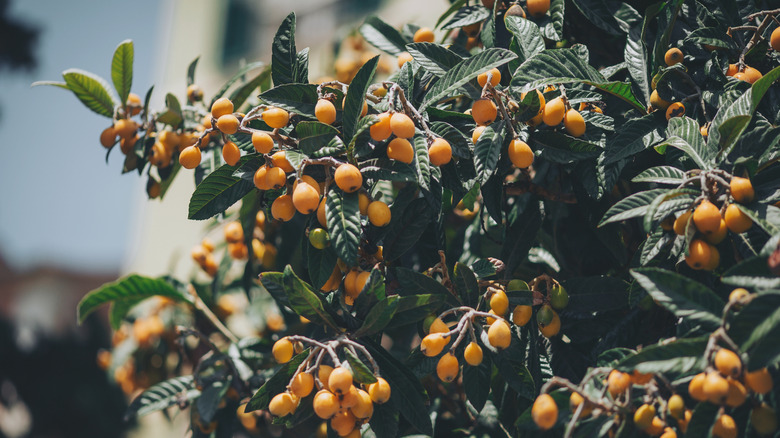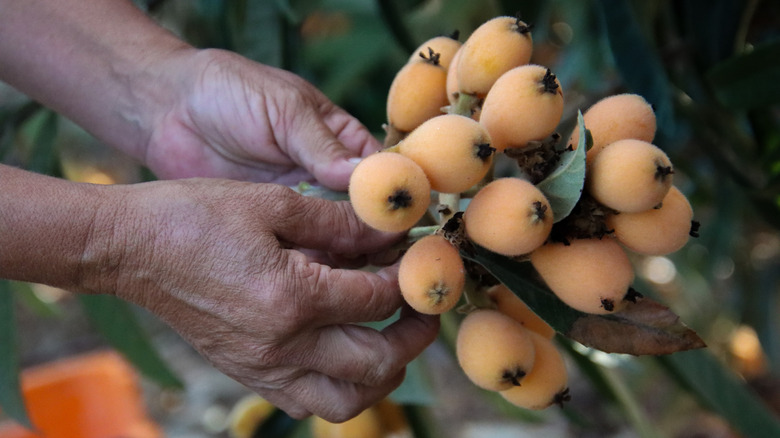The Fast-Growing Fruit Tree You Probably Haven't Heard Of
If you're looking for uncommon fruit trees that have loads of character and grow fast, the loquat (Eriobotrya japonica) may just be the new garden favorite for you. Picture a tree that matures quickly to lend a tropical, lush feel to your outdoor space with verdant, glossy leaves, coupled by clusters of sweet, tangy fruit that resemble an apricot. Native to China and Japan but widely grown globally, the loquat tree is a multitasker in the plant world. It's valued for its ornamental beauty, tasty fruit, and the ability to mature and bear fruit in as little as two to three years — a huge plus if you want a quick harvest.
Planting a loquat tree is not particularly difficult. As long as you have the right growing conditions, it's just a matter of inserting the tree's root ball into a sufficiently large hole, then giving your newly planted loquat plenty of water. Once you plant it, this tree grows at a rate of 1 to 2 feet annually, reaches heights of up 25 feet, and can quickly create a garden cover with its canopy of dark green leaves, which extend to almost a foot in length.
How to plant and care for a loquat tree
Before you plant a loquat in your yard, make sure that the tree will thrive in the local growing conditions. Loquats flourish in the warm, temperate areas of USDA Hardiness Zones 8 to 11 and are one of the best plants to grow in USDA Zone 9. They grow best in full sun and well-draining soil that's either slightly acidic or neutral. Although good drainage helps fruit production, the trees can tolerate wet conditions if they must. Crucially, make sure the site you choose is well-shielded from strong winds.
The best time to plant loquats is in the spring, well before hot weather arrives. When you're ready, dig a hole that's large enough to accommodate the root ball. Loosen the soil around its edges, insert the root ball, and backfill it with soil. Water the tree generously immediately after planting.
Caring for these trees is simple. Once established, loquats are drought tolerant, but they like regular watering, especially in the hottest months of the year. They appreciate being fed with balanced fertilizer during their growing season. Prune them every year after harvest to maintain some shape and promote healthy fruit production. Loquats are resistant to many widespread pests and diseases but may sometimes attract scale insects or fruit flies. With some vigilance, you can keep these annoyances at bay.
Loquats' annual cycle and factors affecting harvests
Loquats bloom toward the end of fall, then bear small, golden-orange fruits in late winter to early spring, depending on your climate. The fruit is sweet, tangy, and juicy, and is usually consumed fresh or used in desserts or preserves. Loquats are self-fertile, and insects like bees and even houseflies can enable a single tree to self-pollinate. So, in theory, loquats don't require another tree to bear fruit. However, cross-pollination helps the fruits set after flowering, and increases the fruit quantity and size. With this in mind, growing more than a single loquat in your yard (and different cultivars, if possible) is beneficial if you're looking for more substantial harvests and higher-quality fruit.
One downside is that although this fruit tree will bring a bountiful harvest to your yard, the fruit itself doesn't keep very long, and loquats lend themselves best to immediate post-harvest consumption or preservation. If you wish to prolong the shelf life of your harvest, you can store the fruits in the fridge, and they should last for a few weeks. Of course, if you love the idea of a tree that provides shade, flowers, and edible fruit in one, this small caveat is easy to overlook.


